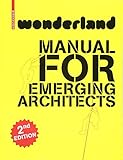wonderland MANUAL FOR EMERGING ARCHITECTS / ed. by wonderland platform for european architecture, Silvia Forlati, Anne Isopp.
Material type: TextPublisher: Basel : Birkhäuser, [2018]Copyright date: ©2019Edition: 2nd, revised editionDescription: 1 online resource (328 p.) : zahlr. farb. AbbContent type:
TextPublisher: Basel : Birkhäuser, [2018]Copyright date: ©2019Edition: 2nd, revised editionDescription: 1 online resource (328 p.) : zahlr. farb. AbbContent type: - 9783035615524
- 9783035615388
- online - DeGruyter
| Item type | Current library | Call number | URL | Status | Notes | Barcode | |
|---|---|---|---|---|---|---|---|
 eBook
eBook
|
Biblioteca "Angelicum" Pont. Univ. S.Tommaso d'Aquino Nuvola online | online - DeGruyter (Browse shelf(Opens below)) | Online access | Not for loan (Accesso limitato) | Accesso per gli utenti autorizzati / Access for authorized users | (dgr)9783035615388 |
Frontmatter -- Editorial -- Prologue -- Contens -- 1. Getting started -- Editorial -- Where to go -- Rules of admission -- Setting up office -- CROSSING BORDERS -- Moving to a foreign country -- What to do -- Mind your design! -- About poaching -- Reality check #1 -- Field of action -- How to keep up -- Negotiation between aesthetics and client demands -- Dance of the marketing mix -- Becoming famous won’t save you -- 2. Making mistakes -- Editorial -- Why make mistakes -- Portals of discovery -- Right mistakes and wrong correctness -- Designing against failure -- A case for the mistake -- Where things can go wrong -- To be an architect is not enough anymore -- Crossing borders -- In detail -- Reality check #2 -- Issues of dispute -- Losing a client -- Wrong use, wrong place, wrong time -- Critical moments -- What to do when things go wrong -- Learning from your mistakes -- Quality management -- Crisis communication -- Architect’s liability and insurance -- Shades of error -- Life after architecture? -- 3. Going public -- Editorial -- Why go public -- A parallel universe -- How low can you go? -- Reality check #3 -- How to disappear completely -- White noise -- Reading architecture -- How to go public -- How to get noticed in the press -- A mirror to the outside -- How to choose an architecture photographer -- Architectural copyright -- Please do judge my book by its cover -- Where to go public -- Where is it leading to? -- Internet platforms -- Countries in detail -- Selfless self-promotion -- 4. Getting started -- Editorial -- Why specialize -- Qualification requirements -- Reality check #4 -- Generalist versus specialist -- Specialization -- What to specialize in -- Other production in Space -- Field – Focus – Tool -- Field – Focus – Tool -- Specialization map -- How to specialize -- Chance or strategy -- Specializing in urban design -- Building information modeling -- How to specialize -- Getting ex-specialized -- 5. Making competitions -- Editorial -- Why make competitions -- Wonderful chances to success and abuse -- The willing suspension of disbelief -- Competition systems: looking for the right one -- Reality check #5 -- Experience reports -- How to make competitions -- An Order of Maria Theresa for Architectural Insubordination? -- Experience reports -- The Europan challenge for young architects -- Architectural competitions in Europe -- What happens next -- Architect vs. Architect? -- Experience reports -- Specialization through participation in architectural competitions -- Research on architectural competitions -- Top ten competitions -- Epilogue -- Table of contents
restricted access online access with authorization star
http://purl.org/coar/access_right/c_16ec
During the first five years of a new architectural practice, typical problems arise that have to be managed. Based on the reports of young architectural practices, which were gathered in workshops throughout Europe, this manual analyzes commonly observed and frequent issues, and offers approaches to resolving them. What is special: the approaches were developed from daily working experience, and can be realistically implemented, not least because they are aimed at the different phases of a developing practice – "Getting started", "Making mistakes", "Going public", "Choosing a specialization", and "Doing competitions". For the second edition the texts were extended and corrected; statistics and charts were brought up to date. The cool presentation remains as appealing as in the first issue.
In den ersten fünf Jahren eines neuen Architekturbüros entstehen typische Probleme, die bewältigt werden müssen. Basierend auf den Erfahrungsberichten junger Architekturbüros, die europaweit in Workshops eingeholt wurden, analysiert dieses Handbuch übereinstimmend beobachtete, häufig auftretende Problemfälle und bietet Ansätze zu deren Lösung. Das Besondere: sie wurden aus der täglichen Arbeitspraxis heraus entwickelt und sind real umsetzbar, auch weil sie auf die verschiedenen Aufbauphasen ausgerichtet wurden: Getting started, Making mistaktes, Going Public, Getting specialized und Making competitions. Für die zweite Auflage wurden die Texte ergänzt und korrigiert, Statistiken und Charts aktualisiert. Das flotte Erscheinungsbild bleibt so ansprechend wie in der ersten Auflage.
Mode of access: Internet via World Wide Web.
In English.
Description based on online resource; title from PDF title page (publisher's Web site, viewed 30. Aug 2021)


